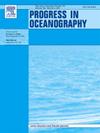Temporal variability of bottom hypoxia in open and semi-enclosed coastal areas in an upwelling region
IF 3.6
3区 地球科学
Q1 OCEANOGRAPHY
引用次数: 0
Abstract
Hypoxia events driven by the onshore advection of oxygen-poor upwelling waters have become increasingly common along Eastern Boundary Upwelling Systems (EBUS). More frequent or intense drops in nearshore oxygen concentrations can impact the behavior, population dynamics, and geographic distribution of many coastal species. To better understand these effects, it is necessary to determine the periodicity of hypoxia in the inner shelf, its response to upwelling-favorable winds, and the local factors that may modify its intensity and duration. Here, we used a two-year record (March 2017–February 2019) of near-bottom dissolved oxygen (DO) and water temperature from seven sites spanning 260 km of the upwelling coast of Central Chile to characterize the local variability in oxygen concentration and its association with coastal winds. The temporal patterns observed in the inner shelf were compared with 13.5 years of monthly hydrographic profiles (2002–2015) from a mid-shelf station located ca. 30 km offshore. The spatial structure of nearshore hypoxia was inferred from hydrographic data gathered during two surveys conducted in winter 2018 and late summer 2019. Inner-shelf hypoxia (DO2.0 mg/L) occurred predominantly in the austral summer and exhibited substantial among-site differences in its persistence and timing relative to wind-driven upwelling. The mean duration of summertime hypoxia events ranged between 1 and 9 days, except for a site at the innermost section of the Gulf of Arauco, where events could be as long as 62 days. Hypoxic waters appeared at the inner shelf after 1–2 days of sustained upwelling-favorable winds (59% of the hypoxia events occurred after 2 days of persistent wind). The seasonality and vertical structure of hypoxia were apparent in the mid-shelf monthly time series, with the hypoxic layer’s upper limit ascending to 20–30 m depths during spring-summer (October–March) and receding to 45–60 m in autumn-winter (May–September). Hydrographic properties of the hypoxic layer pointed to Equatorial Subsurface Water (ESSW) as the source water mass for mid-shelf hypoxia throughout the year. These properties were consistent with those observed on the inner shelf. Among the seven inner-shelf sites, Arauco showed the most persistent (70% of the time spanned by our records) and severe hypoxia, with DO levels below those observed at the mid-shelf during active upwelling. We hypothesize that these conditions respond to a combination of physical phenomena and coastal eutrophication that locally enhance thermal stratification, productivity, and benthic oxygen consumption, thus amplifying the severity of hypoxia and physiological stress for marine organisms inside the Gulf of Arauco.
上升流区开放和半封闭沿海地区底部缺氧的时间变异性
在东部边界上升流系统(EBUS)沿线,由岸上缺氧上升流平流驱动的缺氧事件越来越普遍。近岸氧气浓度更频繁或剧烈的下降会影响许多沿海物种的行为、种群动态和地理分布。为了更好地理解这些影响,有必要确定内陆架缺氧的周期性,其对上升流有利风的响应,以及可能改变其强度和持续时间的局部因素。在这里,我们使用了两年(2017年3月至2019年2月)的近底部溶解氧(DO)和水温记录,这些记录来自智利中部上升流海岸260公里的七个地点,以表征氧浓度的局部变化及其与沿海风的关系。将内大陆架观测到的时间模式与离岸约30公里的中大陆架站13.5年的月度水文剖面(2002-2015年)进行了比较。根据2018年冬季和2019年夏末进行的两次调查收集的水文数据推断出近岸缺氧的空间结构。陆架内缺氧(DO<2.0 mg/L)主要发生在南部夏季,并且相对于风力上升流在持续时间和时间上表现出显著的地点差异。夏季缺氧事件的平均持续时间在1天到9天之间,除了阿劳科湾最深处的一个地点,那里的缺氧事件可能长达62天。在持续1-2天的上升流有利风后,内陆架出现缺氧水(59%的缺氧事件发生在≤2天的持续风后)。中陆架月时间序列缺氧的季节性和垂直结构明显,春夏(10 ~ 3月)缺氧层上限上升至20 ~ 30 m深度,秋冬(5 ~ 9月)缺氧层上限下降至45 ~ 60 m深度。缺氧层的水文特征表明赤道次表层水(ESSW)是中陆架缺氧的源水团。这些特性与在内层架子上观察到的一致。在7个内陆陆架站点中,Arauco显示出最持久的(我们记录的时间跨越的70%)和严重的缺氧,其DO水平低于活跃上升流期间在大陆架中部观察到的水平。我们假设这些条件对物理现象和沿海富营养化的组合作出反应,这些现象和富营养化局部增强了热分层、生产力和底栖动物的氧气消耗,从而放大了阿劳科湾内海洋生物缺氧和生理应激的严重程度。
本文章由计算机程序翻译,如有差异,请以英文原文为准。
求助全文
约1分钟内获得全文
求助全文
来源期刊

Progress in Oceanography
地学-海洋学
CiteScore
7.20
自引率
4.90%
发文量
138
审稿时长
3 months
期刊介绍:
Progress in Oceanography publishes the longer, more comprehensive papers that most oceanographers feel are necessary, on occasion, to do justice to their work. Contributions are generally either a review of an aspect of oceanography or a treatise on an expanding oceanographic subject. The articles cover the entire spectrum of disciplines within the science of oceanography. Occasionally volumes are devoted to collections of papers and conference proceedings of exceptional interest. Essential reading for all oceanographers.
 求助内容:
求助内容: 应助结果提醒方式:
应助结果提醒方式:


